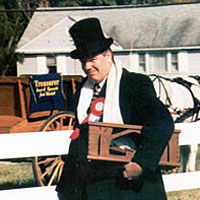 |

手提儀式用短柄小斧的喬治城首長:布斯(Joe
Booth)
1996年的返回日

|
 |
|
 |
返回日
地方性遺產
您知道「埋葬短柄小斧」(意即和解)代表什麼?您知道這句慣用語是出自政治
人物嗎?
1792年,
傳統開始於薩西克斯郡,一個位於德拉瓦州境內的不平凡的城鎮。當時的法律規定,所有的選票都必須投於郡政府所在地:喬治城,來自郡內各地的投票人,會到該城
投下他們的選票,然後當計票作業進行時,他們便回家等待;兩天後,投票人及政治人物會回到喬治城,觀看選舉結果。選舉結果公佈的那天,也就是所有的人回來的那天,就被稱為「返回日」。
當選者當然有理由慶祝他們的勝出,但隨著時間的過去,返回日成為代表慶祝的時間,也成為代表癒合政治不和的時間。到了現在,選舉的投票結果,通常能在投票結束不久後就揭曉,但這項傳統卻保存了下來;典禮的一部分
包括象徵性的「埋葬短柄小斧」,它是沿續自一個古老的美國原住民傳統。敵對的政治人物會一起動手,將一個儀式用小斧埋入沙中,藉以代表政治角力的結束,也代表競選時,候選人間對彼此可能抱持的反感的煙消雲散。
下一次,當您對某人感到憤怒時,為什麼不試著埋葬短柄小斧呢?
Do you know what "to bury the hatchet" means? Did you know this phrase came from politics?
In 1792, an unusual Sussex County, Delaware, tradition started. Back then the law required that all votes had to be cast in Georgetown, the county seat. Voters would arrive from all over the county, cast their ballots, then go home while the votes were counted. Two days later, the voters and politicians would return to Georgetown to find out the election results. The day the results were in and all the people returned was called "Return Day."
Of course the winners had reason to celebrate, but over the years Return Day became both a time to celebrate and a time to heal political differences. Today, votes in an election are usually known soon after the polls close, but this tradition continues. Part of the ceremony includes a symbolic "burying of the hatchet," following an old Native American tradition. Rival politicians together bury a ceremonial hatchet in the sand to show that it is the end of the political race and the end of any hard feelings the candidates may have had about each other during the campaign.
The next time you are angry with someone, why not just bury the hatchet?

 1/1頁
1/1頁

關於地方性遺產

|





